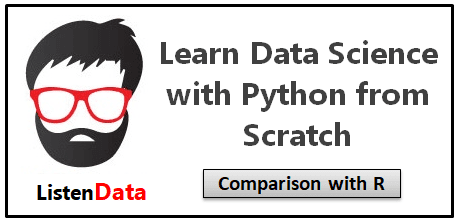This tutorial would help you to learn Data Science with Python by examples. It is designed for beginners who want to get started with Data Science in Python. Python is an open source language and it is widely used as a high-level programming language for general-purpose programming. It has gained high popularity in data science world. In the PyPL Popularity of Programming language index, Python leads with a 29 percent share. In advanced analytics and predictive analytics market, it is ranked among top 3 programming languages for advanced analytics.
Jupyter (Ipython) Notebook Jupyter is equivalent to markdown in R. It is useful when you need to present your work to others or when you need to create step by step project report as it can combine code, output, words, and graphics.
READ MORE » |
| Data Science with Python Tutorial |
Table of Contents
Introduction
Python is widely used and very popular for a variety of software engineering tasks such as website development, cloud-architecture, back-end etc. It is equally popular in data science world. In advanced analytics world, there has been several debates on R vs. Python. There are some areas such as number of libraries for statistical analysis, where R wins over Python but Python is catching up very fast.With popularity of big data and data science, Python has become first programming language of data scientists.There are several reasons to learn Python. Some of them are as follows -
- Python runs well in automating various steps of a predictive model.
- Python has awesome robust libraries for machine learning, natural language processing, deep learning, big data and artificial Intelligence.
- Python wins over R when it comes to deploying machine learning models in production.
- It can be easily integrated with big data frameworks such as Spark and Hadoop.
- Python has a great online community support.
Do you know these sites are developed in Python?
- YouTube
- Dropbox
- Disqus
Python 2 vs. 3
Google yields thousands of articles on this topic. Some bloggers opposed and some in favor of 2.7. If you filter your search criteria and look for only recent articles, you would find Python 2 is no longer supported by the Python Software Foundation. Hence it does not make any sense to learn 2.7 if you start learning it today. Python 3 supports all the packages. Python 3 is cleaner and faster. It is a language for the future. It fixed major issues with versions of Python 2 series. Python 3 was first released in year 2008. It has been 12 years releasing robust versions of Python 3 series. You should go for latest version of Python 3.How to install Python?
There are two ways to download and install Python- Download Anaconda. It comes with Python software along with preinstalled popular libraries.
- Download Pythonfrom its official website. You have to manually install libraries.
Recommended : Go for first option and download anaconda. It saves a lot of time in learning and coding Python
Coding Environments
Anaconda comes with two popular IDE :
- Jupyter (Ipython) Notebook
- Spyder
 |
| Spyder - Python Coding Environment |
from Planet Python
via read more
No comments:
Post a Comment